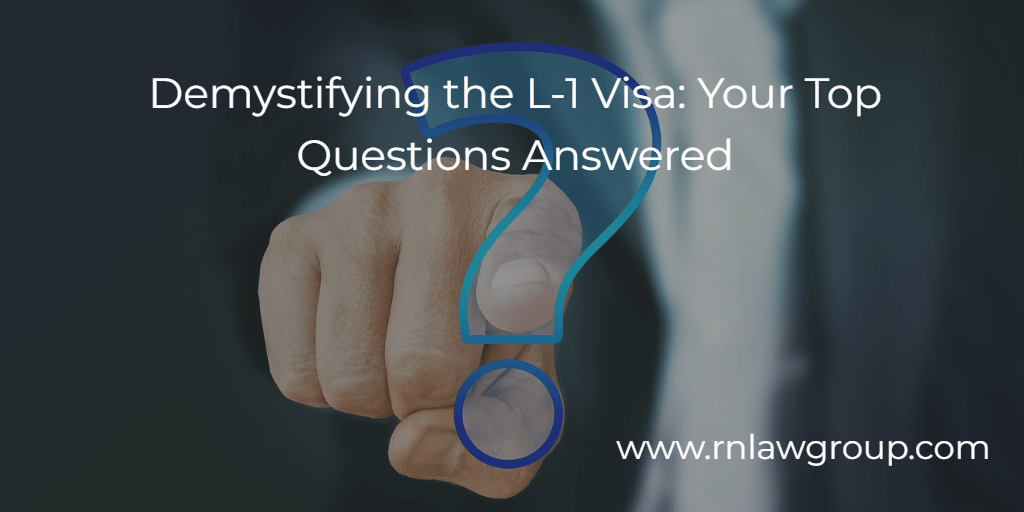
Demystifying the L-1 Visa: Your Top Questions Answered
The L-1 visa stands as a vital tool for international businesses, facilitating the transfer of key personnel between overseas and U.S. branches. However, navigating the intricacies of this visa category can be daunting. To shed light on this topic, we’ve compiled a comprehensive guide addressing the most frequently asked questions about the L-1 visa:
- What is an L-1 Visa?
At its core, the L-1 visa enables multinational companies to transfer certain employees from foreign offices to U.S. locations. It comes in two main categories: L-1A for managers and executives and L-1B for employees with specialized knowledge. The visa allows companies to leverage their global talent pool while expanding operations in the United States.
- Who Qualifies for an L-1 Visa?
To qualify for an L-1 visa, both the employer and the employee must meet specific criteria. The company must have a qualifying relationship between its overseas and U.S. entities, such as parent, subsidiary, or affiliate. Additionally, the employee being transferred must have worked for the overseas company for at least one continuous year within the preceding three years.
- What is Considered “Specialized Knowledge”?
Specialized knowledge refers to expertise or knowledge of the company’s products, services, processes, or procedures that is not readily available in the U.S. labor market. This could include proprietary technology, unique methodologies, or industry-specific knowledge that is essential to the company’s operations.What is the Duration of Stay on an L-1 Visa?
Upon approval, L-1 visa holders are initially granted a stay of up to three years, with extensions available for a total maximum period of seven years for L-1A visa holders and five years for L-1B visa holders. Extensions beyond these limits may be possible through other visa categories or pathways to permanent residency.
- Can L-1 Visa Holders Bring Family Members?
Yes, L-1 visa holders can bring their spouses and unmarried children under 21 years of age to the United States on L-2 visas. Dependent family members are permitted to study in the U.S. and, in some cases, obtain employment authorization.
- Can L-1 Visa Holders Apply for Green Cards?
L-1 visa holders may pursue permanent residency (green card) status through employment-based immigration pathways, such as the EB-1C category for multinational managers and executives. The L-1 visa can serve as a stepping stone toward obtaining permanent residency in the United States.
- Can L-1 Visa Holders Start Their Own Businesses in the U.S.?
While L-1 visa holders are primarily employed by the sponsoring company, there are avenues for entrepreneurship in the U.S. For example, L-1 visa holders may be eligible to apply for an EB-5 investor visa if they invest a substantial amount of capital in a new commercial enterprise that creates jobs for U.S. workers.
- Can L-1 Visa Holders Change Employers?
L-1 visa holders are typically sponsored by a specific employer for a specific position. However, they may be able to change employers under certain circumstances, such as if the new employer files a new L-1 petition on their behalf or if they transition to a different visa category.
- What is the Process for Applying for an L-1 Visa?
The L-1 visa application process involves several steps, including the submission of a petition by the U.S. employer to U.S. Citizenship and Immigration Services (USCIS), along with supporting documentation demonstrating the qualifying relationship between the overseas and U.S. entities and the qualifications of the employee being transferred.
- Are There any Alternatives to the L-1 Visa?
While the L-1 visa is a popular choice for intra-company transfers, there are alternative visa options available depending on the individual’s qualifications and circumstances. For example, the E-2 visa is available to investors from certain treaty countries, while the H-1B visa is an option for specialized workers in specialty occupations.
In conclusion, the L-1 visa serves as a valuable tool for multinational companies seeking to transfer key personnel to the United States. By understanding the requirements, benefits, and limitations of the L-1 visa, employers and employees can navigate the process with confidence, ensuring a smooth transition and successful integration into the U.S. market.
- Can L-1 Visa Holders Travel In and Out of the U.S. Freely?
L-1 visa holders are generally allowed multiple entries into the United States during the validity of their visa. However, they must ensure that their visa and I-94 status remain valid and comply with any travel restrictions or requirements imposed by U.S. immigration authorities.
- Is There a Cap on the Number of L-1 Visas Issued Annually?
Unlike some other visa categories, such as the H-1B visa, there is no annual numerical cap on the number of L-1 visas that can be issued. As long as the employer and employee meet the eligibility criteria, L-1 visas can be issued throughout the year.
- Can L-1 Visa Holders Apply for Work Authorization for Their Spouses?
Yes, spouses of L-1 visa holders on L-2 visas are authorized to work without having to apply for work authorization.
- Are L-1 Visa Holders Required to Maintain a Foreign Residence?
While there is no specific requirement for L-1 visa holders to maintain a foreign residence, they are expected to maintain ties to their home country and intend to depart the United States upon completion of their authorized stay. This can include retaining a residence, family, or other significant connections abroad.
- Can L-1 Visa Holders Study in the United States?
L-1 visa holders are generally permitted to engage in part-time or full-time study in the United States, provided that their primary purpose for being in the country remains employment-related. They may need to obtain additional documentation or authorization from their employer or USCIS depending on the nature and duration of their studies.
- Can L-1 Visa Holders Bring Domestic Workers to the United States?
L-1 visa holders who are executives or managers (L-1A) may be eligible to bring personal domestic workers, such as maids or nannies, to the United States under certain conditions. The domestic worker must have been employed by the L-1 visa holder for at least one year within the preceding three years and must intend to work full-time for the visa holder in the U.S.
- Are There Any Specific Requirements for L-1 Visa Extensions?
When applying for an extension of stay on an L-1 visa, employers must continue to demonstrate the qualifying relationship between the overseas and U.S. entities and the employee’s continued eligibility. Additionally, they must provide evidence of the employee’s ongoing employment and any changes in job duties or location.
- Can L-1 Visa Holders Change Their Visa Status Within the United States?
In some cases, L-1 visa holders may be eligible to change their visa status within the United States, such as transitioning to another visa category or applying for adjustment of status to obtain permanent residency (green card). However, they must meet the eligibility criteria and follow the appropriate procedures.
- Can L-1 Visa Holders Work Part-Time or for Multiple Employers?
L-1 visa holders are generally authorized to work only for the sponsoring employer in the specific position for which their visa was granted. Working part-time or for multiple employers may require additional authorization or a change of visa status, depending on the circumstances and applicable immigration regulations.
- What Happens if an L-1 Visa Holder’s Employment is Terminated?
If an L-1 visa holder’s employment is terminated for any reason, their authorized stay in the United States may be affected. They should consult with an immigration attorney or USCIS to understand their options, which may include departing the United States, changing visa status, or seeking alternative employment sponsorship.
In summary, the L-1 visa serves as a vital conduit for multinational corporations, enabling the seamless transfer of talent across borders. Our comprehensive guide addresses the key questions and uncertainties surrounding the L-1 visa process, empowering employers and employees to navigate this complex pathway with confidence.
By: Felipe Jimenez
Felipe Jimenez is an Associate Attorney at Reddy & Neumann, P.C. He works in the Non-Immigrant Visa (NIV) Department where he assists clients through all phases of the non-immigrant visa process.
Reddy & Neumann, P.C. has been serving the business community for over 20 years and is Houston’s largest immigration law firm focused solely on US. Employment-based immigration. We work with both employers and their employees, helping them navigate the immigration process quickly and cost-effectively.

